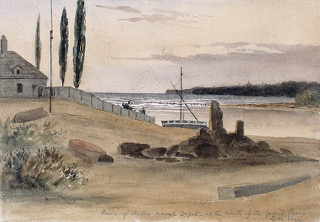The Re-Establishment of the British Navy on Lake Erie, 1814-1834
DOI:
https://doi.org/10.25071/2561-5467.1236Keywords:
British North America, Royal Navy, naval establishment, Great Lakes, Lake Erie, Grand River, War of 1812Abstract
At the conclusion of the War of 1812 the British navy needed to establish a new naval yard on the upper Great Lakes. Penetanguishene became the site for the main establishment, but its isolated location off of Georgian Bay necessitated a naval depot on Lake Erie where the British squadron was anticipated to spend much of its time. This paper examines the selection process resulting in choosing the mouth of the Grand River as the best location from among a less than optimum set of options for the naval dockyard. Elements such as depth of water, the ease of entering the space, what shelter from weather the land provided, the ease of fortifying the area, location of the navy yard along the shore and the site for ship building had to be considered. The convenience of the supporting supply line and its accessibility to enemy incursions were two further points in the decision-making exercise. The life of the naval establishment from conception through its closing in 1834 is described in light of British economic, military defence decisions, and British-American diplomatic agreements.
À la fin de la guerre de 1812, la marine britannique devait établir un nouveau chantier naval sur la partie supérieure des Grands Lacs. Penetanguishene est devenu le site du principal établissement, mais son emplacement isolé au large de la baie Georgienne a nécessité un dépôt naval sur le lac Érié où l’escadron britannique devait passer la majeure partie de son temps. Cet article examine le processus de selection qui a abouti au choix de l’embouchure de la rivière Grand comme meilleur emplacement parmi un ensemble d’options loin d’être optimales pour le chantier naval. Des éléments tels que la profondeur de l’eau, la facilité d’accès à l’espace, l’abri offert par le terrain contre les intempéries, la facilité de fortification de la zone, l’emplacement du chantier naval le long du rivage et le site de construction navale devaient être pris en compte. La commodité de la ligne de ravitaillement de soutien et son accessibilité aux incursions ennemies étaient deux autres points de l’exercice de prise de décision. La vie de l’établissement naval, depuis sa conception jusqu’à sa fermeture en 1834, est décrite à la lumière des decisions britanniques en matière de défense économique, militaire et des accords diplomatiques anglo-américains.
References
Benn, C. (ed.). A Mohawk Memoir from the War of 1812 John Norton – Teyoninhokarawen. Toronto, ON: University of the Toronto, 2019. DOI: https://doi.org/10.3138/9781487519902
Bourne, K. Britain and the Balance of Power in North America 1815-1908. Los Angeles, CA: University of California Press, 1967. DOI: https://doi.org/10.1525/9780520324220
Brock, T. “Commodore Robert Barrie and his Family in Kingston, 1819-1834.” Historic Kingston 23 (March 1975): 1-18.
Burt, A. The United States Great Britain and British North America; From the Revolution to the Establishment of Peace After the War of 1812. New Haven, CT: Yale University Press, 1940.
Cruikshank, E. “An Episode of the War of 1812: The Story of the Schooner Nancy.” In The Defended Border: Upper Canada and the War of 1812, ed. M. Maslow. Toronto, ON: MacMillan Company, 1964.
Docker, J. Grand River Naval Depot. Dunnville, ON; Dunnville Historical Society, 2000.
Gordon, Leeanne E. “Newash and Tecumseth: Analysis of Two Post-War of 1812 Vessels on the Great Lakes.” MA thesis, Texas AM University, 2009.
Gough, B. Through Water, Ice Fire: Schooner Nancy of the War of 1812. Toronto, ON: Dundurn Group, 2006.
Gough, B. Fighting Sail on Lake Huron and Georgian Bay: The War of 1812 and its Aftermath. St. Catharines, ON: Vanwell, 2002.
Harris, R. and T. Harris (eds.). The Eldon House Diaries: Five Women’s Views of the 19th Century. Toronto, ON: The Champlain Society, 1994. DOI: https://doi.org/10.3138/9781442654099
Hughes, A. “The Feeder Canal and its Communities.” Newsletter of the Historical Society of St Catharines, September 2007.
Klinck, C and J. Talman (eds.). Journal of Major Norton 1809-16. Toronto, ON: The Champlain Society, 1970.
Knight, R. Britain Against Napoleon: The Organization of Victory 1793-1815. London, UK: Alan Lane, 2013.
MacKay Hitsman, J. The Incredible War of 1812: A Military History. Toronto, ON: Robin Brass Studio, 1999.
Malcomson, R. Lords of the Lake: The Naval War on Lake Ontario, 1812-1814. Toronto, ON: Robin Brass Studio, 1998.
Malcomson, R. and T. Malcomson. HMS Detroit: The Battle for Lake Erie. St Catharines, ON: Vanwell, 1990.
Malcomson, T. “The Penetanguishene Decision: To Be a Naval Yard or Not to Be.” Ontario History 113, no. 1 (Spring 2021): 1-26. DOI: https://doi.org/10.7202/1076075ar
Malcomson, T. “Commodore Sir Edward W.C.R. Owen: Shaping the British Naval Establishment on the Great Lakes in the Wake of the War of 1812.” The Northern Mariner/Le marin du nord 24, no. 1 (Spring 2019):1-24. DOI: https://doi.org/10.25071/2561-5467.215
Malcomson, T. “Rear Admiral Sir Robert Barrie, KCB KCH (1774-1841) - St Augustine, Florida.” In From Across the Sea North America’s in Nelson’s Navy, eds. S. Heuvel and J. Roodbaard. Warwick, UK: Helion Company Limited, 2020.
Preston, R. “Broad Pennants at Point Frederick.” Ontario History 50 (1958): 81-90.
Stanley, G. The War of 1812: Land Operations. Toronto, ON: Macmillan of Canada, 1983.
Wood, William. Select British Documents of the Canadian War of 1812, Volume 3, Part 1. Toronto: Toronto Champlain Society, 1926.

